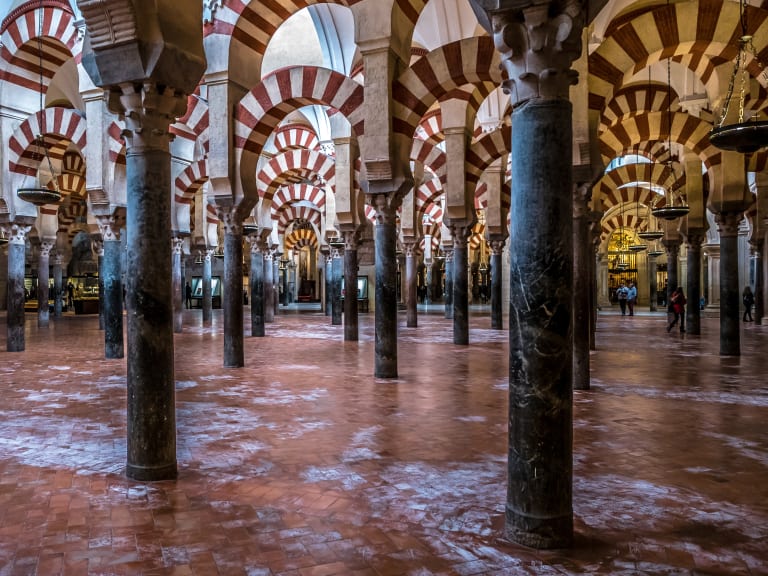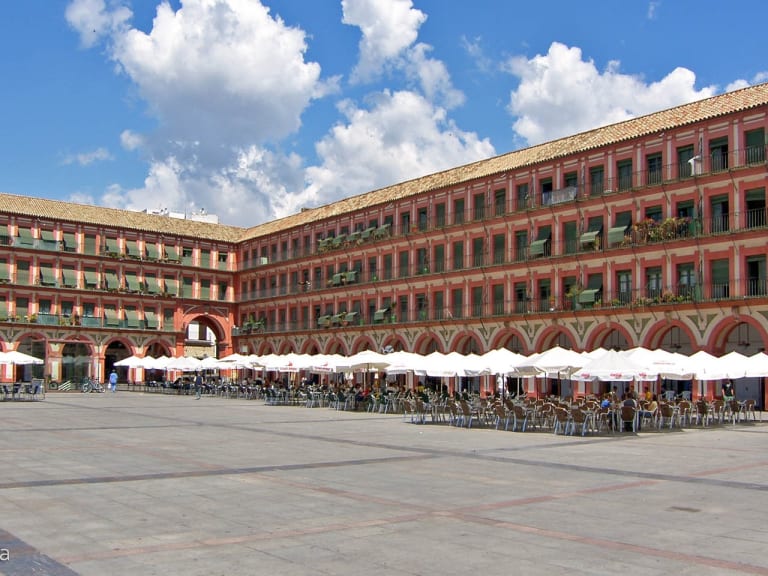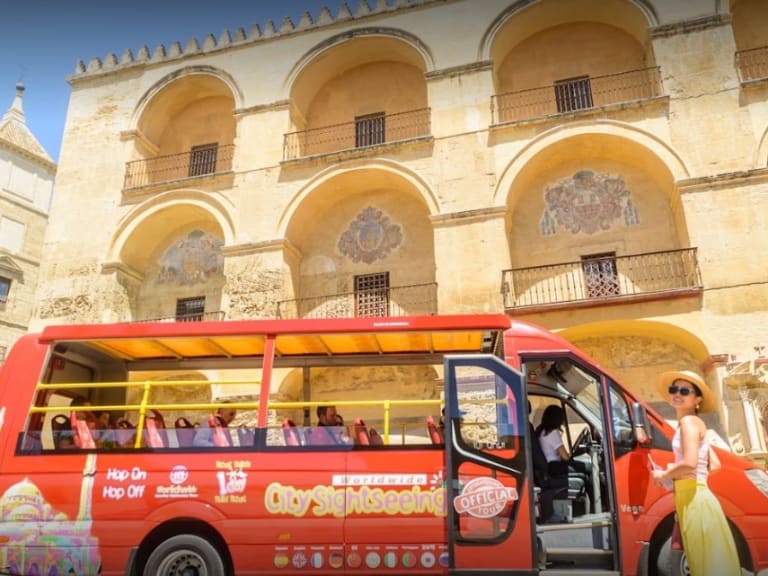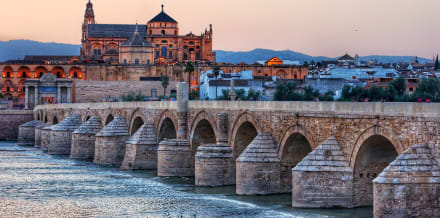More about: Best Things To Do In Cordoba In 2 Days
If you're planning a weekend getaway to Cordoba or you're just passing through and have only 2 days to get to know the city, this article is for you. While Cordoba is a city with a huge variety of things to see and do, you'll have plenty of time to see the main sights of the city and take away the best of Cordoba.
You'll get to see the Mosque-Cathedral of Cordoba, the Alcazar of the Christian Monarchs, the Roman Bridge, the Calahorra Tower, the Viana Palace and much more. Here is an itinerary to help you organise your 2-day trip around Cordoba without missing anything.
Day 1: Mosque-Cathedral, Alcázar of the Christian Monarchs, the Jewish Quarter, Roman Bridge and Calahorra Tower

You will only have to see the most iconic attractions on the first day of your stay in Cordoba to fall madly in love with the city and want to return, but with the feeling that you have seen enough.
Visit the Mosque-Cathedral of Cordoba
The Mosque-Cathedral of Cordoba is the first thing I recommend you to see in the city, as it could be defined as its main attraction.
It is one of the most visited monuments in Spain, and once you get to know it you will understand why. Everything about it is amazing, the Patio de los Naranjos at the entrance, its imposing columns, the marked Umayyad art from the time of the Caliphate of Cordoba, together with Gothic, Baroque and Renaissance elements, make it a true work of art.
Considering that it is the most visited attraction in Cordoba and that you only have two days to tour the city, I advise you to avoid wasting time queuing to get in by buying your tickets in advance. I leave you with this article where you can learn more about this attraction and get your tickets for the Mosque-Cathedral of Cordoba.
Visit the Alcazar of the Christian Monarchs
After visiting the Mosque-Cathedral of Cordoba, less than 10 minutes walk, you will arrive at the Alcazar of the Christian Monarchs which is the second most visited monument in Cordoba, after the Mosque and you should definitely include it in your itinerary.
It is a military building built by King Alfonso XI of Castile in 1328 and, as part of the historic centre of Cordoba, it was declared a World Heritage Site by UNESCO in 1994. Several historical landmarks took place here, such as the visit of Christopher Columbus to present his project that ended in the discovery of America.
It has amazing architecture and is famous for its colourful and extensive gardens, fountains and ponds, but I also recommend you visit the Moorish Patio and the Patio de las Mujeres and climb the Torre de los Leones for the best views.
Considering it is one of the most visited sites, I recommend you buy your tickets in advance to avoid the queues.
Stroll through the Jewish Quarter

Once you have finished your visit to the Alcázar de los Reyes Cristianos, the Judería, an iconic quarter of Cordoba, originally inhabited by Jewish families between the 13th and 15th centuries and today one of the city's main attractions, awaits you just a few metres away, which you can walk around in less than 10 minutes.
Every detail of this neighbourhood is excellently preserved, its narrow cobbled streets, its colourful courtyards decorated with a variety of flowers and all the history that is breathed in every corner is one of the things you will enjoy the most when you walk around it.
I recommend that you choose a guided tour to explore this neighbourhood in depth, without missing anything and making the most of your time. Here you can find all the information you need about the best tours of the Jewish Quarter to make your visit a success.
Lunch stop: recommendations
The Judería is a good place to grab a bite to eat and recharge your batteries before continuing with the day. There you will find a wide variety of restaurants serving typical Cordovan food and you can even enjoy some flamenco shows.
Personally, I recommend Casa Pepe De La Judería which is one of the best restaurants in Cordoba that offers a wide menu of typical food and is recognised for its excellence and quality, highlighted in the Michelin guide.
Another good option is the Patio de la Judería which has a unique style. It is built on what used to be an 18th century manor house, all its dishes are made with fresh, quality and local products and there are usually live flamenco shows.
Cross the Roman Bridge
After having a bite to eat in the Jewish quarter, you will walk back a few streets towards the mythical Roman Bridge, which is located over the Guadalquivir River and currently connects the Cathedral quarter with the Campo de la Verdad quarter. It has a long history, as its construction dates back to the 1st century BC when Cordoba was under the rule of Augustus.
Its good state of preservation and its exquisite Roman architecture are truly admirable. Moreover, walking across this bridge you will be able to contemplate the best sunset you can imagine and you will have the most marvellous views of the river, the Mosque-Cathedral and the amazing flora and fauna that inhabits the Sotos de la Albolafia nature reserve.
Climbing the Calahorra Tower
Through the Roman Bridge, you will reach the Calahorra Tower, which is another site that is part of the great historical heritage of Cordoba and is not to be missed. It is a fortress of Islamic origin that since ancient times has been a symbol of control, defence and protection.
In the Calahorra Tower you can visit the Living Museum of Al-Andalus, where you can take a journey through the culture of Cordoba in the Middle Ages and see the co-operation and coexistence of religions as diverse as Christianity, Judaism and Islam in one of the largest cities in Spain.
Bear in mind that touring the Museum will take you no more than 2 hours. And here's a special recommendation: take advantage of the unique panoramic view from the top floor of the Calahorra Tower. It will be a unique experience, as from there you will be able to appreciate another perspective of the Roman Bridge, the Mosque-Cathedral and the Alcázar of the Christian Monarchs.
To visit the Museo Vivo de Al-Andalus you should buy your ticket for around 4.5 euros and bear in mind the opening hours: from Monday to Sunday, from 10am to 7pm all year round, and in summer, from 10am to 2pm and from 4.30 to 8.30pm.
Day 2: Medina Azahara, Palacio de Viana, Roman Temple and Archaeological and Ethnological Museum

To make the most of your second day in Cordoba, I recommend you start with a guided tour of Medina Azahara, have something to eat to recharge your batteries and in the afternoon visit the Palacio de Viana, the Roman Temple and finish at the Archaeological Museum.
Take a guided tour of Medina Azahara
A trip to Cordoba should not miss a trip to Medina Azahara, one of the most renowned and important archaeological sites in Europe. It is an ideal complement to the tour of the Mosque-Cathedral, so that you can understand what represented the splendour of Cordoba during the 10th century during the Caliphate.
It is located just 8 kilometres from Cordoba and was declared a UNESCO World Heritage Site in 2018. My recommendation is to visit it on a guided tour from Cordoba, so you can save time and get to know it in depth. Bear in mind that this archaeological site has a lot of history to tell among its ruins and having the experience of an expert guide is a great advantage.
Excursions to Medina Azahara leave from Cordoba in the morning and take around 3 hours. The price is about 17 euros per person approximately.
Visit the Viana Palace
After the tour of Medina Azahara I recommend you to continue your second day at the Palacio de Viana. It is located in the heart of the Santa Marina neighbourhood and is one of the most beautiful and picturesque places in Cordoba.
It is a very luxurious 14th century residence that houses 12 Cordoban courtyards with a remarkable Islamic and Roman architecture that characterises the whole city and its visit represents a great cultural, artistic and historical value.
Touring this palace is an incredible experience, you can relax as you stroll through its courtyards, tour the house and learn about its history, its museum, its remodelling and the various owners it has had over the years.
If you plan to visit Cordoba in summer, you can visit the Palacio de Viana between 9am and 3pm from Tuesday to Sunday. The rest of the year, between 10am and 7pm. To save time and avoid queues, you can buy your tickets in advance on the official website for around 10 euros.
Traveller Tip
You can visit the 12 courtyards of the Palacio de Viana for free every Wednesday during the special opening hours from 2 to 3 p.m. in summer and from 2 to 7 p.m. the rest of the year.
Stop for lunch: recommendations
Near the Palacio de Viana you can enjoy a bite to eat and recharge your batteries for the rest of the day. You'll have a good range of typical Cordovan cuisine to enjoy.
I recommend one of the taverns in the area, such as Taberna Las Beatillas, one of the oldest in the city that preserves the spirit, art and culture of Cordoba in every corner.
Another option is to enjoy some Andalusian tapas at the Taberna San Miguel Casa El Pisto, which is located a little closer to the next stop, the Roman Temple.
Visit the Roman Temple
After a bite to eat, a few metres from Palacio de Viana and about 10 minutes walking, you will arrive at the Roman Temple which will be the next stop on your tour of the city of Cordoba. It could be said that this temple was found by chance during an extension of the city hall in 1950 and it is a very imposing structure due to its enormous dimensions.
It is dedicated to imperial worship and demonstrates the grandeur of Cordoba in Roman times. It is made up of six main columns and two lateral ones and its state of conservation is truly worthy of admiration. Some of its original pieces are exhibited in the city's Archaeological Museum.
Stroll around the Corredera Square

A few metres from the Roman Temple you can find the Plaza de la Corredera and appreciate another of the classic sites of the city of Cordoba. It was created at the end of the 17th century and is considered to be the only rectangular main square in Andalusia.
Its history is very interesting, as over the years it has had various uses, such as a prison, a bullfighting arena, a witness to the executions of the Inquisition and a market. It was also declared a historical and artistic monument.
Visit the Archaeological and Ethnological Museum
To conclude your visit to the city, you will walk about 7 streets from the Plaza de la Corredera and you will arrive at the Archaeological and Ethnological Museum of Cordoba, which is considered the second most important museum in Spain.
In this museum you will find a variety of pieces that correspond to the different civilisations that inhabited the city of Cordoba over the years, which makes it the ideal place to go through the history of the city from beginning to end.
You'll find unique works of all kinds from the Roman, Visigothic and Islamic eras, and you can learn a little more as you explore the museum's exhibits.
Please note that you will need to book your guided tour at least one day in advance on the museum' s website and the approximate entrance fee is just over 1 euro.
Cordoba's tourist bus, an ally for your 2-day visit

I have excellent news for you: the tourist bus of Cordoba includes almost all the attractions I mentioned in this article and it will be your great ally to get to them. As you only have two days to visit the city, you will need to optimise your time and for that you will find this tourist bus with free stops.
With this option you will have 17 stops distributed in the main places of the city and you will be able to move from one place to the other, using it as a means of transport without spending too much money.
In this way, all the attractions will be perfectly connected, you just have to pay attention to the stops and always have a map at your fingertips to guide you. You will be able to make the most of it to explore the whole city, as you will be able to get off at each of the attractions you want to visit in depth and explore the main neighbourhoods of Cordoba.
The ticket costs approximately 18 euros per person and you can book it for 24 or 48 hours, depending on your preference.




